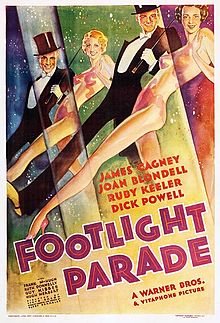 James Cagney: tough guy, song-and-dance man. Singing and dancing in a bar-cum-opium den?
James Cagney: tough guy, song-and-dance man. Singing and dancing in a bar-cum-opium den?
Welcome to the wonderful world of the 1930s Warner Bros. musical- where women are dames, wisecracks whistle back and forth backstage and anything goes if it can just dodge the censors.
Musicals are my favourite genre. I grew up loving the crème-de-la-crème of the MGM back catalogue, as well as Fred Astaire and Ginger Rogers’ pictures for RKO. Both studios possessed conspicuous house styles: MGM was big, bold and deliciously extravagant; RKO specialized in sleek, art deco chic.
Yet none of this quite prepared me for the brash, boisterous glory of Warner Bros. In the early 1930s Warners made a name for itself as the most socially conscious studio in Hollywood, winning audiences by putting America’s mean streets up on screen. A string of gangster pictures depicted the nation’s criminal underbelly, often with plots ripped from the headlines for increased sensationalism and supposed authenticity. Little Caesar, The Public Enemy and Angels with Dirty Faces all hail from here. It’s no surprise then that the home of hard-hitting realism would produce such a distinctive brand of musical: escapism laced with grit.
In fact Footlight Parade tackles the harsh realities of the Great Depression head on, or at least in its first reel. Chester Kent (James Cagney) is a stage impresario and performer driven out of work by talking pictures. Jobs are scarce, so he invents his own: producing ‘prologues’- short, glamorous musical numbers performed on stage between movie screenings. Kent’s creativity quickly establishes his reputation as best in the business, but he struggles to come up with fresh ideas while simultaneously fending off competitors. Luckily his long-suffering Girl Friday, Nan (Joan Blondell), is always at hand. With a lucrative prologues contract up for grabs, will Chester stay in business long enough to win? Will he get the better of his exploitative backers? And will he ever notice Nan?
Like Chester’s dancers, the film is marvellously fleet of foot, a breezy comedy propelled by plenty of wit, charm and stock characters. There’s Bea (Ruby Keeler), the plain Jane praised only for her brains; Scotty (Dick Powell), her cocky love interest; and a perpetually harassed dance instructor always about to quit. They’re all entertaining but the movie really belongs to Cagney and Blondell, whose sparkling partnership drives many of its best scenes. Blondell’s performance especially is a revelation- sassy, street-smart, vulnerable and wise. Cagney bounds across the screen with infectious enthusiasm; she follows his antics in amused exasperation. Footlight Parade was their sixth pairing together and I’m now eager to see the rest.
Glitz and glamour, but where’s the grit?
It’s in Chester’s desperate determination to succeed; in Nan’s mordant quips; and in the film’s remarkably frank attitude to relationships.
Indeed a similar frankness- coupled with a gleeful disregard for moral guardians- informs the movie’s spectacular, all-singing, all-dancing finale. Warners backstage musicals revolve around production numbers and Footlight Parade showcases three of legendary choreographer Busby Berkeley’s very best. In ‘Honeymoon Hotel’ Keeler and Powell wander through an elaborate recreation of one, playing newly-weds slowly realizing they’re the only married couple staying amidst multiple Mr. and Mrs. Smiths. It’s a bawdy, risqué and astonishingly humorous take on infidelity which pushed the boundaries of thirties censorship. (For the filmmakers’ own opinion of censors, look no further than the hypocritical buffoon Chester is forced to employ.) Next is ‘By a Waterfall’, a 15-minute synchronized swimming extravaganza that’s the forerunner of Esther Williams’ films for MGM. In fact I’m pretty sure Berkeley reused the ‘flower’ pose years later in Million Dollar Mermaid. (Smoke! Slides! Swings! Sparklers! Mermaid’s climax is even more astonishing than ‘Waterfall’. ) Ruby Keeler and a shoal of precipitously-clad women float in Berkeley’s signature kaleidoscopic patterns, frolicking in an enormous plunge pool that has no business on a real Broadway stage. The overall effect is dazzling and I marvelled at the imagination, dedication and precision it took to create them. Incidentally, Berkeley’s unique style stems from his experience coordinating military formations- he was never trained as a traditional choreographer.
Happily, Berkeley saves the best number for last: ‘Shanghai Lil’, an elaborate Oriental confection. James Cagney was a born hoofer who rarely had the chance to sing and dance onscreen; it really is our loss. Here he’s Bill, in half-drunken pursuit of the girl deemed ‘every sailor’s pal/anybody’s gal’. To my amazement, he staggers through an opium den populated by decorative, languishing beauties as part of his search. Early Hollywood is full of surprises. Thankfully the various attempts at underworld colour are ignored as soon as Bill finds Lil (Keeler, once again). For sheer exuberance and brio, little compares with the duo tap dancing on a bar counter- they stop the show.
There’s so much to savour in this film: lavish sets, witty dialogue, great performances and simply superb singing and dancing. I thoroughly enjoyed this trip into Warners musicals. Bring on the next one!
Leave a Reply